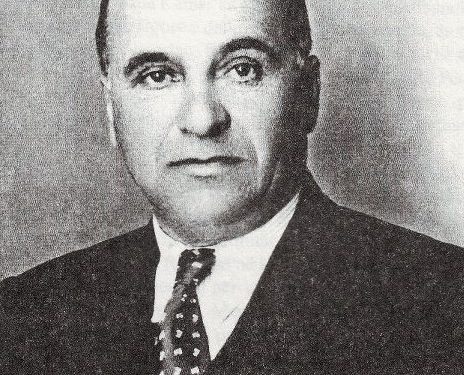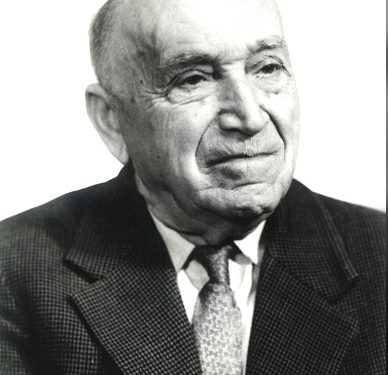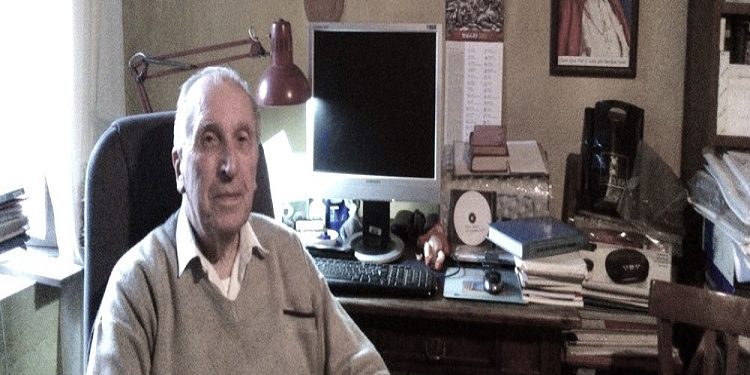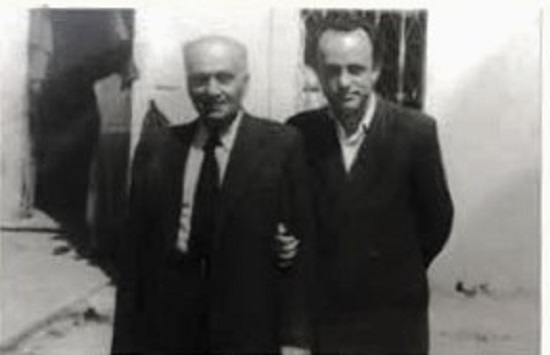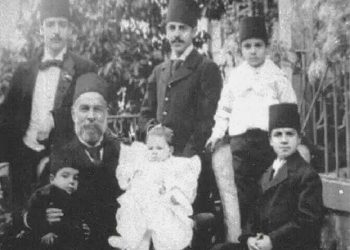The first part
-Kolë Kamsi, the intellectual who devoted his life to education and scientific research –
Memorie.al / In this paper, light will be shed on Kolë Kamsi, an intellectual who dedicated his life to education in Albania, about whom little has been written until today. The analysis of the image of Kola Kamsi will mainly be developed through the comparative analysis of archival sources and media writings and articles published on him. Born on September 23, 1886 in Shkodër, the father of three children, Paolini, Carlos and Terezina Kamsi, with a social origin of a small merchant and a teacher by profession, has made his contribution in the field of education and national culture. Scientific personality, folklorist, teacher and pedagogue of the Albanian language, designer of school textbooks, translator, prose writer, fabulist, publicist, editor, outstanding researcher of the Albanian language and social traditions.
The Kamsi family is not a family without influence in Shkodër. Behind this surname, there is an old history of this family with an important contribution in the national aspect. In fact, the surname Kamsi is closely related to Drishti of Postriba Municipality. Drishti has been one of the most developed centers since the 12th century. Kamsi is the surname of one of the two branches of the family of the rulers of Drishti, the Angels.
The family has its roots in Dhimitër Ejlli, then it was divided into two branches, that of Kamsi and Radovani. With the occupation of Drishti and its fortress by the Ottomans, the Angels were dispersed. A part of them takes the surname Kamsi, owning the villages between Cukal and Drishti and thus they are distributed in different areas of Shkodra. This is how the story of Kamsi begins, from the eldest son of this family, Karlo Kamsi. “Furthermore,” continues Karlo, “in the area of Drishti, even today, the toponyms related to the name of this family are preserved, such as Guri i Kamxi (Kamsi), Cave of Kamsi, Kulat e Kamcejve, Dheu i Kamsi, etc.
Also interesting is the name they got after the disbandment of the Angels. One of the members of the Kamsi family, named Denk Kamsi, was known for his fast walking and thus earned the nickname “Kamci”, or swift-footed.
Referring again to Karlo Kamsi, it is known that in his family, 16 original documents, parchments, are fanatically preserved, which talk about the antiquity of this family. Not only the State Archive, but also the Vatican, has requested the documents that talk about the seniority of the Kamsi family. “In addition to the genealogical family tree,” Karlo Kamsi confesses, “these documents also talk about the economy and cultural development of the area, legal acts of the time, etc.”!
One of the most prominent figures of this family was Monsignor Pal Kamsi, who served as parish priest of the Church of Our Lady of Shkodra in Tophanë and on May 25, 1742, was appointed by Pope Benedict XIV as Bishop of Shkodra. Pal Kamsi, during his service in Tivar, became known for being the first to register in the church book, which is kept in the Archdiocese of Shkodra. He led the Diocese of Shkodra for 29 years and passed away on April 14, 1771, in the Franciscan Assembly of Kastrati.
Gjon Kamsi is another very interesting figure, who immediately reminds you of the refusal that Pope Clement XII gave, in 1739, to be Bishop of Shkodra. The life John Camus preferred to lead was among the common people. He passed away at the age of 90 and left his wealth to the poor. Other names from this well-known family were Col. Ndoc Kamsi and Bep Kamsi, the latter served as a translator at the Venetian consulate in Shkodër.
Willy Kamsi confesses that Gjon Kamsi, his father, was another intellectual of the Kamsi family. Gjon Kamsi developed his activity in Bari, Italy, where Willy Kamsi himself was born. He was a collaborator of the national press, inside and outside the country, as well as a member of foreign journalists in Italy. He has published in popular magazines of that time, such as “Posta e Shqypnia” and “Bashkimi i Kombit”. Among other things, he has collaborated with many other newspapers and magazines, among which the five-year collaboration with the prestigious “Hylli i Drita” stands out.
“My uncle Kolë Kamsi,” continues Willy Kamsi, “studied the same way as my father, first in Shkodër and then in Italy. Willy Kamsi himself had worked in the library of the city of Shkodra and had multiplied the number of books in its collection. After the 90s, he served as the first full-fledged ambassador of Albania in the Vatican and when he returned to Shkodër, after his diplomatic service, he compiled the bibliographic series of the most important magazines of the period before the establishment of the communist regime in Albania.
He has devoted himself to the publication of several important works, such as the four complete volumes with bibliographies, of the magazines “Hylli i Drita”, “Leka”, “Albania” (by Konica), “Shejzet” and “Skhëndija” (by Ernest Colic), and important historical materials, such as; The historical diary of Shuk Gurakuqi, the Memoirs of Gjon Kamsi and other studies with a historical character. Willy Kamsi deals with history, cultural monuments and archaeology, Albanian language, mainly with etymology of historical toponymy and other scientific fields.
Seen in this light, the genealogical tree of the Kamsi family is a tree where many intellectuals stand out. Seeing this progress, of course Kolë Kamsi would also be part of this process. His course was almost predetermined, if we look at the family in which he grew up. Kolë Kamsi would be just the next name that would contribute widely in the field of education.
He started his path to knowledge in his hometown, in Shkodër, where he received his first lessons, completing primary and secondary school, thus also receiving a diploma at the Italian Trade Technical School. He would complete the ‘Normal’ school in San Demetrio Corone (Italy) and Italian would be one of the languages he would master best. He would stay here for three years, where he would finish the Normal Pedagogical School in 1907.
In this college, the chair of the Albanian language was founded by Jeronim de Rada in 1849, and in this educational institution, professor Aleksandër Xhuvani taught in the Albanian language from 1906 to 1909, as well as studied after 1897, the patriot, politician and the prominent Albanian intellectual, Luigj Gurakuqi. In 1907, after completing his studies, at the age of 21, Kolë Kamsi returned to his birthplace, with devotion and dedication, to serve his country in the field of education. This same year, he was appointed a teacher of the Albanian language, in the district of Vlora, this district which in this period inherited marked backwardness in the field of education. Getting really familiar with the state of education in Vlorë and Gjirokastër, Kamsi undertook the opening of 44 elementary schools to teach Albanian to the children of these two districts.
After exercising his activity as a teacher for a long time for seven consecutive years, in the school year 1915-1916, he was appointed the director of the first elementary school for boys, in the prefecture of Vlora, and the teachers in this school were appointed Jani Minga, Thoma Papapano and Halim Xhelo Tërbaçi. In this period, being aware of the low level of teachers who taught in schools, Kamsi together with Jani Mingë opened a short-term pedagogical course in Vlora, which aimed to help teachers to use didactic methods during teaching.
Kamsi, in addition to running the schools and teaching, began an intensive activity, which was related to the drafting of basic texts for the primary school where, apart from the primer he titled “New Life” (1915), of 72 pages, he got down to work and within four years ago, he wrote the text “Teachings about nature” (1917), 60 pages, and in 1919, he published the anthology of poems for elementary school, “Flowers of thought”, 52 pages.
In these years, Kolë Kamsi becomes a member and activist of the patriotic Club “Labëria” and stands out as an activist of the educational and cultural movement; “Teachers’ Union” in Vlora, a movement that exercised its activity in the years 1907-1928. In these years, Kolë Kamsi managed to stage the drama “The Death of Pyrrhus”, by Mihal Gramenos. In the district of Vlora, Kamsi exercised his activity for the opening and management of Albanian schools until 1920, during a period of 13 years. After the end of the First World War, he returns to Shkodër.
In the years 1910-1920, he worked as a teacher in Vlora. By order of the Ministry of Foreign Affairs, he worked as a simple teacher at the Italian school in Vlora. In the years 1912-1916, his payment in Vlora was 220 fr. gold. In the school year 1915-1916, a primary school for boys was opened in Vlora, the director of which was named Kolë Kamsi. By order of the Prefecture, he is appointed director of the Albanian school in Vlora. In 1916-1917, his monthly salary, based on archival documents, in the position of director, was 240 fr. gold.
The staff of teachers in this school consisted of names such as: Jani Minga, Thoma Papapano, Halim Xhelo, etc. According to archival documents, in the years 1917-1920, in the position of teacher, Kolë Kamsi received a salary of 220 fr. gold. In the years 1920-1926, he was in the same position, but in Shkodra, with the same payment. Between these years, he was appointed a teacher in Shkodër, by order of the Ministry of Education, at the Franciscan School, in the years 1920-1922. Likewise, Kamsi is one of the delegates to the Second Educational Congress in Tirana, this congress which held the works in the building of the First Albanian Parliament.
Exciting in the first meeting of the works of this congress, which was held on Saturday, July 22, 1922, at 10:00, was the speech given by the Minister of Education at that time, Mr. Rexhep Mitrovica, who addressed the participants: ” Honorable Sirs, I feel very glad to see around me, the most valuable powers of education, assembled here to beat matters of great importance, for the awakening of our people, and for the advancement of their culture, which may are earned only through schools. With education, we will not only ensure the freedom and independence of our nation, but we will also improve its economic and health conditions, two points no less important than political freedom and independence”.
Professor Kolë Kamsi, together with professors Kol Margjini, Thoma Papapano and Dhimitër Gjergo, are appointed secretaries of this congress, by vote of the participants, and professor Karl Gurakuqi is charged with writing the report, which will be written on the basis of the minutes kept in congress, where Kolë Kamsi, together with the professors; Xhuvani, Kondo, Pogoni, Beltoja, Gurakuqi, Çekaj, Minga, Bala, Gashi, Babameto and Papapano are elected members of the commission of 12 people, as a representation of the participants from the various districts of the country, who would prepare the educational reform, programs and textbooks and would make decisions about the progress of the education system in Albania.
The aim of this congress was to carry out an educational reform, the curriculum of which had to prepare in the future citizens with steadfast character, iron will, initiative and fair judgment, to serve the nation and to bring it out the country from the centuries-old backwardness, where it had sunk.
Precisely at this moment, the efforts of the deputy of Shkodra from the opposition wing, Luigj Gurakuqi, who session after session expressed the need for the creation of a secondary school, were great and continuous.
Regarding the concern, for the urgent need to open a secondary state secular school in the city of Shkodra, he presented it to the Albanian parliament, in January 1922, at the 10th meeting of the National Council, which took the floor immediately after the speech of the Minister of Education at that time, Rexhep Mitrovica, where, among other things, he said: “On this point, I want to remove the warning to the Minister of Education, to take the necessary measures to open a secular secondary school , why there all the people, who want math for education. High schools in this city are private and belong to religious beliefs.”
Thus, the Council of Ministers of the Albanian State, in 1922, on August 11, takes decision no. 720, “based on the request of the Ministry of Education, no. 11878, a decision ordering the opening of a school in Shkodër, the State Gymnasium, so that a majority of Albanian students, who have not been sent abroad, and especially the students of that District, can attend lessons there. .”!
On 05.10.1922, the Ministry of Education opens the State High School, with a very modest material base, in which the first 20 high school students are enrolled and professors are appointed; Kolë Kamsi (Albanian language and literature), Loro Rasha (Latin), Kol Kraja (French), Kol Margini (history-geography), Ruhi Zheko (mathematics), Simon Rrota (drawing), Demush Jakova (gymnastics). After two months, he appointed the first director of this high school, Professor Xhevat Korça (history-geography) and deputy director, Luigj Shala (natural history).
By the same order of the Ministry of Education, he was appointed a teacher in the years 1922-1924, at the State Gymnasium in Shkodër, and in 1924-1925, Kamsi was appointed director by the Ministry of Education in Shkodër, at the “Teuta” school. In 1925, by order of the Ministry of Education, he was appointed director and teacher of the pedagogical course that the Ministry opened in the district of Korça, for the preparation of teachers who would teach in the schools of the city of this district. The educators who attended this course expressed the highest consideration for the help given to them by Professor Kolë Kamsi, with the aim of improving the new didactic methodologies for teaching.
Assessments for the skills and values of the course followed by Professor Kamsi can be found through the article titled; “Pedagogy courses for teachers of Korça and the districts”, published in the newspaper “Zëri i Korçë”: “Mr. Kamsi is the director and teacher of the courses and stands out for his clear and understandable language, thus attracting the attention of all teachers, which are alienated, to learn methods that are as easy as possible for schools”. Five weeks later, in the “Gazette of Korça”, VII, September 05, 1925, after the end of this course, the 12 participating teachers expressed gratitude for the dedication that Professor Kamsi had towards them, through an article.
At the end of the article, all 12 participating teachers signed the letter as a sign of gratitude to Professor Kamsin with this dedication: “To the course director, Professor Kamsin, who with tireless activity and energy, uses the most pleasant method for the development of didactic lessons, from which we are getting a great benefit. We thank him from the bottom of our hearts and congratulate him for these qualities he has”.
In this same year, 1924, he was the director and teacher in a pedagogical course for city and district teachers. From 1926 to 1928, he worked at the Trade Institute in Vlora, where he was appointed director by the Ministry of Education. Specifically, in 1926, he was the director of the Commercial School and the Cold Water Boarding School, in Vlora. In this position, he is rewarded with a payment of 300 fr. gold.
In addition to the presentation of these mechanical facts, what I cannot overlook is precisely a letter from Kolë Kamsi, dated December 31, 1926, in Vlora and addressed to the magazine Diturija, where he made a large contribution to the publication of several articles. Textually, Kolë Kamsi expresses himself as follows in the letter: “With the new year, recognize me as a subscriber of the temporary Diturija, which has started to be published under the direction of Mr. s’uej”.
Further on in the letter, his Western spirit is also noted in contributing some thoughts of foreign writers, mainly in French and Italian: “I also sent you some selected thoughts of foreign writers, which I have summarized according to the subject which I have to be published separately among the temporary issues”. Memorie.al




